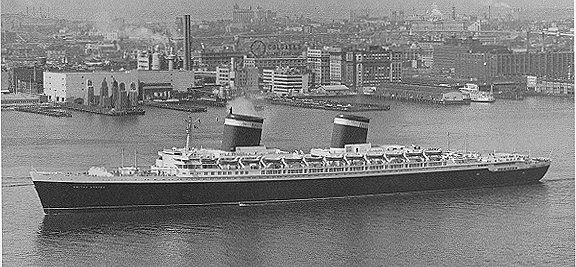Mother of All
Rummage Sales

Oct. 3, 1984
Has your garbage disposal's appetite for forks left you with an odd number? Here's an offering of 50 silverplate dinner forks. Expecting company? How about 3,000 pillowcases? Maybe you need 36 dozen whiskey sour glasses? A lifeboat? Twenty hand-cranked telephones?
There are a few hitches. For one thing, none of the offerings is under 15 years old. And you'll have to fight some of the world's leading art and antique dealers to get at them.
Because this rummage sale is no church choir fundraiser. It is the auction of the contents of the S.S. United States.
If there was ever a Legend of the Sea, it is the United States. She was launched June 23, 1951 in Newport News, Va., and plied the Atlantic during a period that was at the same time the heyday and the dying gasp of the great passenger steamships. The "Big U," as her crews called her, represented the pinnacle of maritime engineering and technology.
As much of her as possible was made of lightweight alumimum alloys. Her four huge steam turbine engines produced 240,000 horsepower.
Running wide-open, those engines could ram this five city blocks of steel, glass and aluminum through the waves at an astonishing 50 knots -- or so it was said. Because the engines never were run wide-open; in fact, it is said only three of those four powerplants was ever lit off at once, thanks to builder William Francis Gibbs' fanaticism about keeping her capabilities secret.
What the record books do show is that on her maiden voyage in 1952, the United States steamed from New York to Southampton, England in only three days, 10 hours and 40 minutes, and three days, 12 hours and 12 minutes on the return -- an average speed of 38 knots. It was the fastest trans-Atlantic crossing ever by steamship, for which she was awarded the coveted Hale's Trophy and Blue Riband. The record still stands.
Her 2,000 passengers -- first, cabin and tourist classes alike -- rode in air-conditioned, streamlined elegance, attended by 1,050 crew members.
The United States was an American ship, and damned proud of it, flaunting her heritage with Austin Purves' aluminum renderings of state birds and flowers, and Peter Ostuni's enamel-on-copper recreations of Navajo sand paintings.
In the end, though, speed and beauty weren't enough. Even as champagne corks were popping in celebration of the record three-day crossing, the airlines were already writing the end of the steamship
era on their schedule boards.
In 1969, they doused the United States' fires for the last time. She was taken to the Norfolk International Terminal and mothballed, a kind of maritime limbo reserved for ships too valuable to scrap and too expensive to run. There she sits, to this day.
But not for long, now. Because in 1981, along came salvation in the person of Richard Hadley and United States Cruises, who bought the United States and intend to sail her again, this time as a cruise ship.
Before she can go into the shipyard for conversion and repair, though, her new owners have to dispose of literally thousands of knives, forks, plates, towels, ashtrays ... well, a sign reading "Closing-Out Sale of the S.S. United States -- Everything Must Go!" would best describe what is to transpire Oct. 8-14, 1984.
Of course, Guernsey's, the auction house running the show, is a little more high-toned than that. They've put out a dignified catalogue of the offerings, which range from classical nautica such as ship's wheels and Chelsea clocks, to streamlined aluminum "art moderne" vases and lamps, to some angular armchairs and sofas that are best described as ... well, ugly.
Much of the auction seems geared to dealers, especially in the china, silverware, and linen departments, where the offerings are in lots ranging from the dozens into the thousands. Very few individuals can afford, or have any use for, 49 dozen Lamberton china boullion cups, even if they are emblazoned with the United States Lines' proud eagle. Or 25 International silverplate escargot holders. Or 400 tablecloths.
Even if you can't afford any of it, it is nice to dream. Look -- Lot F190: Here's the actual champagne bottle with which the wife of then-Texas Sen. Tom Connally christened the ship, all done up in aluminum and net, "containing original glass shards and appropriate dent." It will no doubt bring a pretty price, even if it is somewhat damaged.
There's Lot F200, a Steinway baby grand piano, the one from the ballroom -- "the main piano used by the Meyer Davis Orchestra for 'memorable evenings at sea.'" Or the furnishings and artworks from the staterooms often reserved by the Duke and Duchess of Windsor.
If your tastes run to the kinky, there are four sets of handcuffs and leg irons being auctioned, as well as a strait jacket. Want to set up your own newspaper? They're selling a Linotype, two printing presses and other equipment from the ship's print shop.
And if, like me, you tend to go overboard (no pun intended) in pampering your pet, you can pick up some tan kennel blankets. The minimum lot seems to be 10, though.
The list goes on, endless and endlessly fascinating. Menu covers, radar sets, an operating table, waiters' uniforms, deck chairs, life jackets -- even, ominously, gas masks and radiological monitoring equipment. (In war, the United States would have functioned as a troopship.)
Competition for most of the lots will be fierce, and I'm sure the big-time dealers will walk off with the best pieces. The peons will have to be satisfied with baggage tags, post cards, logbooks, signs and other small items classed as "Memorabilia" and auctioned during the daily "Memorabilia Hour."
But even to be there without a cent to bid would be quite a treat.
It's the only chance most of us have to meet America's First Lady of the Sea without booking a stateroom.